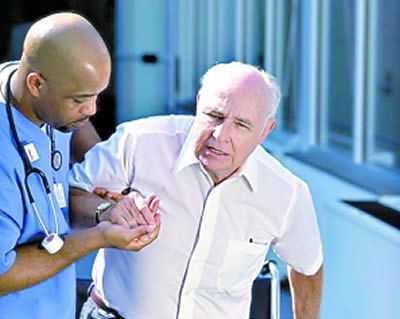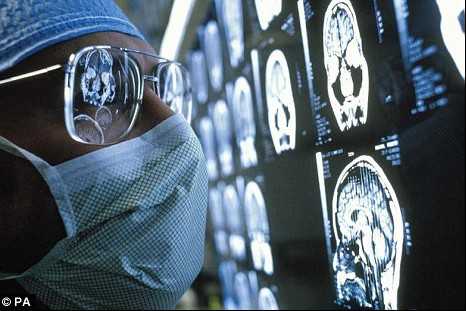NEJM:金刚烷胺可加快脑损伤后意识恢复
2012-04-14 爱思唯尔 爱思唯尔
3月1日,《新英格兰医学杂志》(New England Journal of Medicine)发表的一项国际、随机、双盲、安慰剂对照研究显示,为期4周的金刚烷胺治疗能够加快创伤性脑损伤(TBI)后意识障碍患者的功能恢复速度。 在这项研究中,新泽西州JFK约翰逊康复研究所的JosephT.Giacino博士及其同事从3个国家的11家医疗中心纳入184例入组前4~16周出现非穿透TBI并正在接受常

3月1日,《新英格兰医学杂志》(New England Journal of Medicine)发表的一项国际、随机、双盲、安慰剂对照研究显示,为期4周的金刚烷胺治疗能够加快创伤性脑损伤(TBI)后意识障碍患者的功能恢复速度。
在这项研究中,新泽西州JFK约翰逊康复研究所的JosephT.Giacino博士及其同事从3个国家的11家医疗中心纳入184例入组前4~16周出现非穿透TBI并正在接受常规院内康复的16~65岁患者。患者被诊断为植物状态,即有觉醒但没有自觉意识的行为证据,或处于最低限度的意识状态,以及具有至少1个清晰可辨的意识行为迹象。所有患者的残疾等级量表(DRS)评分均高于11分,该量表的评分范围为0分(最佳)至29分(最差)。采用修订版昏迷恢复量表(CRS-R)评价发现,没有1例患者能够始终遵循命令或进行功能性沟通。87例患者随机接受金刚烷胺治疗,97例患者接受外形相同的安慰剂处置,疗程为4周。初始剂量为100mg(2次/d),如果DRS评分相对基线未改善至少2分,则在第3周将剂量增至150mg(2次/d),第4周增至200mg(2次/d)。此后减停金刚烷胺或安慰剂,并随访评价患者6周。主要预后终点是治疗期间DRS评分的改善率。由不知晓治疗分组情况的跨学科治疗小组每周对DRS评分进行1次评价。研究者采用CRS-R来评价具有临床相关性的行为指标。
结果显示,4周治疗结束时,2组的DRS评分均显著改善,但金刚烷胺组的改善速度明显更快(–0.24分/周或更多)。此外,在最终随访评价时,金刚烷胺组DRS评分改善的患者比例较大,处于植物状态的患者比例较小,关键行为指标恢复的患者比例也较大。然而,在停止药物治疗后,疗效降低,最终随访评价时,2组之间无显著差异,表明疗效依赖于药物的应用。具体而言,治疗期间金刚烷胺组能够实施6种具有临床相关性的行为之一的患者比例高于安慰剂组,但最终随访时2组之间无显著差异。这6种行为分别为始终遵循命令、物体识别、物体的功能使用、明了的言语表达、可靠的肯定或否定沟通,以及持续注意力。
研究者表示,金刚烷胺并不增加不良生理、神经系统和行为事件(包括癫痫发作)的风险。金刚烷胺能够有效地加快创伤后长期意识障碍患者的急性康复速度及加快重要认知行为的恢复。不过,尚不清楚长期治疗对远期预后的影响,这方面还有待于进一步研究。
该研究获美国国立残疾与康复研究所资助。Giacino博士声明无相关经济利益冲突,但有一位研究者与爱力根等多家公司存在经济关系。其他研究者为TBI和意识障碍患者提供专家鉴定。(生物谷Bioon.com)

doi:10.1056/NEJMoa1102609
PMC:
PMID:
Placebo-Controlled Trial of Amantadine for Severe Traumatic Brain Injury
Joseph T. Giacino, Ph.D., John Whyte, M.D., Ph.D., Emilia Bagiella, Ph.D., Kathleen Kalmar, Ph.D., Nancy Childs, M.D., Allen Khademi, M.D., Bernd Eifert, M.D., David Long, M.D., Douglas I. Katz, M.D., Sooja Cho, M.D., Stuart A. Yablon, M.D., Marianne Luther, M.D., Flora M. Hammond, M.D., Annette Nordenbo, M.D., Paul Novak, O.T.R., Walt Mercer, Ph.D., Petra Maurer-Karattup, Dr.Rer.Nat., and Mark Sherer, Ph.D.
Background
Amantadine hydrochloride is one of the most commonly prescribed medications for patients with prolonged disorders of consciousness after traumatic brain injury. Preliminary studies have suggested that amantadine may promote functional recovery.
Methods
We enrolled 184 patients who were in a vegetative or minimally conscious state 4 to 16 weeks after traumatic brain injury and who were receiving inpatient rehabilitation. Patients were randomly assigned to receive amantadine or placebo for 4 weeks and were followed for 2 weeks after the treatment was discontinued. The rate of functional recovery on the Disability Rating Scale (DRS; range, 0 to 29, with higher scores indicating greater disability) was compared over the 4 weeks of treatment (primary outcome) and during the 2-week washout period with the use of mixed-effects regression models.
Results
During the 4-week treatment period, recovery was significantly faster in the amantadine group than in the placebo group, as measured by the DRS score (difference in slope, 0.24 points per week; P=0.007), indicating a benefit with respect to the primary outcome measure. In a prespecified subgroup analysis, the treatment effect was similar for patients in a vegetative state and those in a minimally conscious state. The rate of improvement in the amantadine group slowed during the 2 weeks after treatment (weeks 5 and 6) and was significantly slower than the rate in the placebo group (difference in slope, 0.30 points per week; P=0.02). The overall improvement in DRS scores between baseline and week 6 (2 weeks after treatment was discontinued) was similar in the two groups. There were no significant differences in the incidence of serious adverse events.
本网站所有内容来源注明为“梅斯医学”或“MedSci原创”的文字、图片和音视频资料,版权均属于梅斯医学所有。非经授权,任何媒体、网站或个人不得转载,授权转载时须注明来源为“梅斯医学”。其它来源的文章系转载文章,或“梅斯号”自媒体发布的文章,仅系出于传递更多信息之目的,本站仅负责审核内容合规,其内容不代表本站立场,本站不负责内容的准确性和版权。如果存在侵权、或不希望被转载的媒体或个人可与我们联系,我们将立即进行删除处理。
在此留言














#金刚烷胺#
59
#损伤#
0